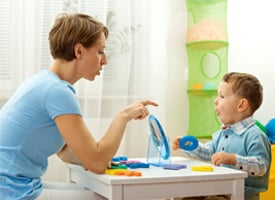 Playing with your child is a essential way to improve his/her speech, language, and social skills! Below are five different toys and ways to play with your child to encourage language growth and development:
Playing with your child is a essential way to improve his/her speech, language, and social skills! Below are five different toys and ways to play with your child to encourage language growth and development:
Mr./Mrs. Potato Head:
- Following Directions: Ask your child to give you various parts. If this is too simple, ask him/her in a more complex way. For example, instead of asking for Mr./Mrs. Potato Head's shoes, say "the ones you put on your feet.” Sometimes this works best after the child has built Mr./Mrs. Potato Head and is asked to follow the directions of placing each part back into the box.
- Giving Directions: Have your child tell you which part to put on. Be sure he/she uses the longest and most complete sentence possible. Don’t accept single word responses if your child is capable of saying things such as “Put on the shoes.”
- Taking Turns: Take turns with your child as you each add an item to the Mr./Mrs. Potato Head. Decide, together, if it will be a silly or more standard looking one. Be sure each person says “my turn!” when switching off.
- Prepositions: After the Mr./Mrs. Potato Head is assembled, place it in various locations around the room/house. You can have your child follow the direction you give or express the place he/she chose to place the toy - “Mr./Mrs. Potato Head is under the chair/next to the table/on the seat/etc.”
- Verbs: Have Mr./Mrs. Potato Head act out actions and describe him/her using pronouns and verbs. For example, “He is jumping!” or “She is sleeping.” You may even want to get the entire potato family!
Stacking Blocks:
- Expressing: Say what you are doing with a variety of descriptive words. Talk about what you and your child are building. For example, “We are making a tall tower” or “This is a school.”
- Anticipation: Practice readiness with your child as you knock down the stacked blocks. Say “Ready, set, go!” with a pause between each word, and have your child anticipate when the blocks fall and go boom! This exercise may take a little practice and can be customized base on your child's language development skills.
- Making Choices: Give your child options to choose the block he/she wants. For example, instead of asking if he/she wants a block, be more descriptive - "Do you want a red or green block?” You can also ask if your child wants to stack the blocks higher or knock them down.
- Environmental Noises: Children will often imitate exclamations easier than words. Use a variety of sounds and exclamations while playing such as “uh-oh," "pop," "boom," "wow," and "crash.”
- Following 2-Step Directions: Use the stacking blocks as a method to teach your child how to follow two directions that related to one another. For example, "Get the blue block and give it to me," or "Open the box and take out the red block."
Simple Wooden Puzzles:
- Requesting: Remove all the pieces and give your child the board. Have him/her ask for each piece one-by-one. It's okay if your child says “more” if the labels are challenging.
- Labeling: Talk about each puzzle item using a variety of nouns and descriptive words.
- Making Choices: Hold out two pieces and ask your child which one he/she wants. Be sure your child requests his/her choice by using a sign, a complete word, or a complete sentence, depending on his/her language level.
- Repeating Phrases: Repetition is key! Saying things such as “We did it,” “It went in” or other simple phrases over and over again after your child places down each piece, helps with language development.
- Giving Directions: Have your child tell you which piece to place in the puzzle next.
Toy Cars:
- Vocabulary Words: Expand your child’s language by using words such as “drive," "park," "beep," "fast," "slow," "stop," "go,” etc.
- Ask Questions: For example, “Where is your car going," "What color is your car," "Who drives my car?”
- Environmental Sounds: Cars and trucks may make siren noises, crash or rev their engines. Practice a variety of these fun sounds during play.
- Describing Actions: Talk about what your car/truck is doing. For example, “My car is going up a hill., or, “Your car is in front of my car. It is fast.”
- Parallel Play: Share the experience and have fun with your child by merely playing next to him/her.
Toy Food:
- Verbs: For example: “Let’s cut the pizza," "Pour the milk," "Eat the banana," "Bite the apple,” etc.
- Descriptive Words: In addition to using verbs, also incorporate adjectives such as “hot," "cold," "long," "red," etc.
- Social Routines and Skills: Learning social skills are essential in a child's development. Have your child give you a “bite” of food or make a toast with your cups. You can also practice setting the table or cleaning up.
- Follow Directions: Ask your child for different foods or to place them in separate containers. You can make your directions as straightforward or as complex as your child can understand. You can also include positional words such as “in," "on," "under," "next to,” etc.
- Requesting Items: Have your child request which food, drinks or dishes he/she would like. Be sure to ask appropriate questions geared to your child's language-level. The wording may merely be the item said with a requesting voice. For example, “I want an apple,” or, for a more complex question, “May I please have the yellow plate?”
Click here to learn more ways to help develop your child's language skills through play.









